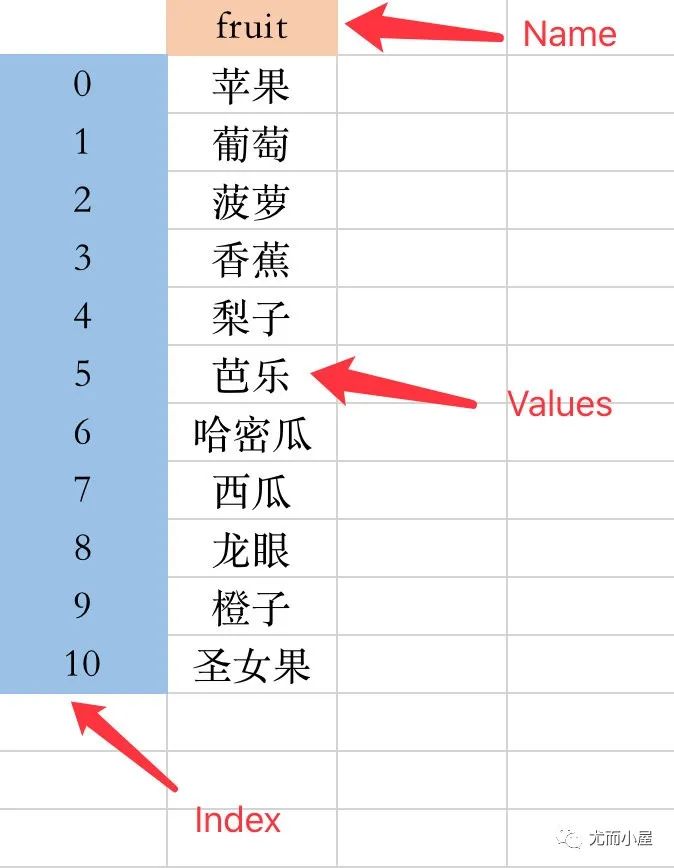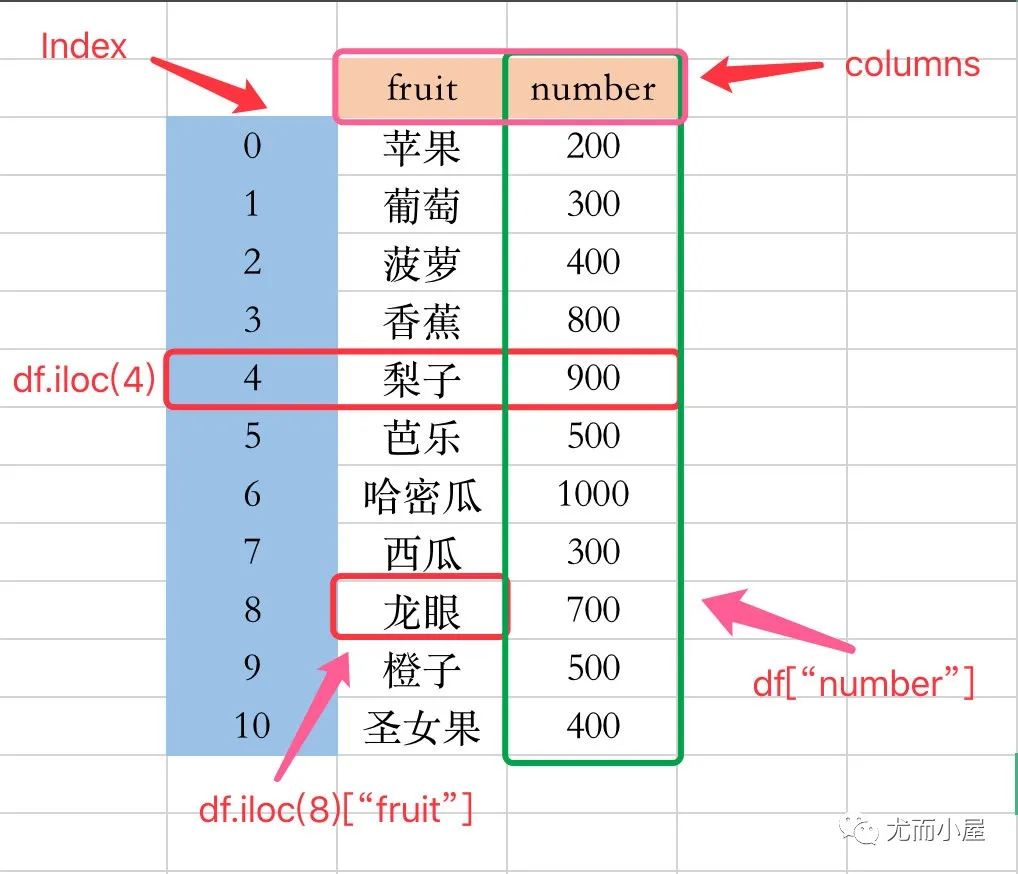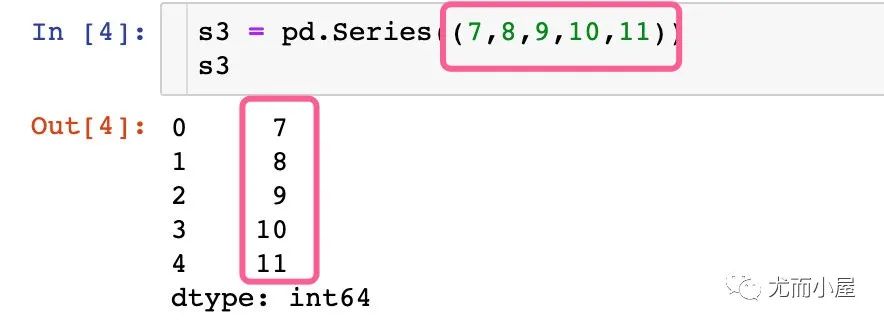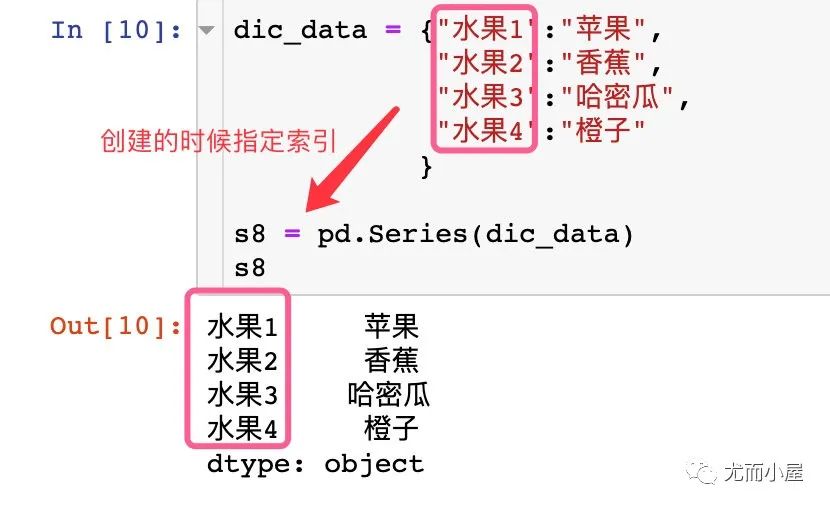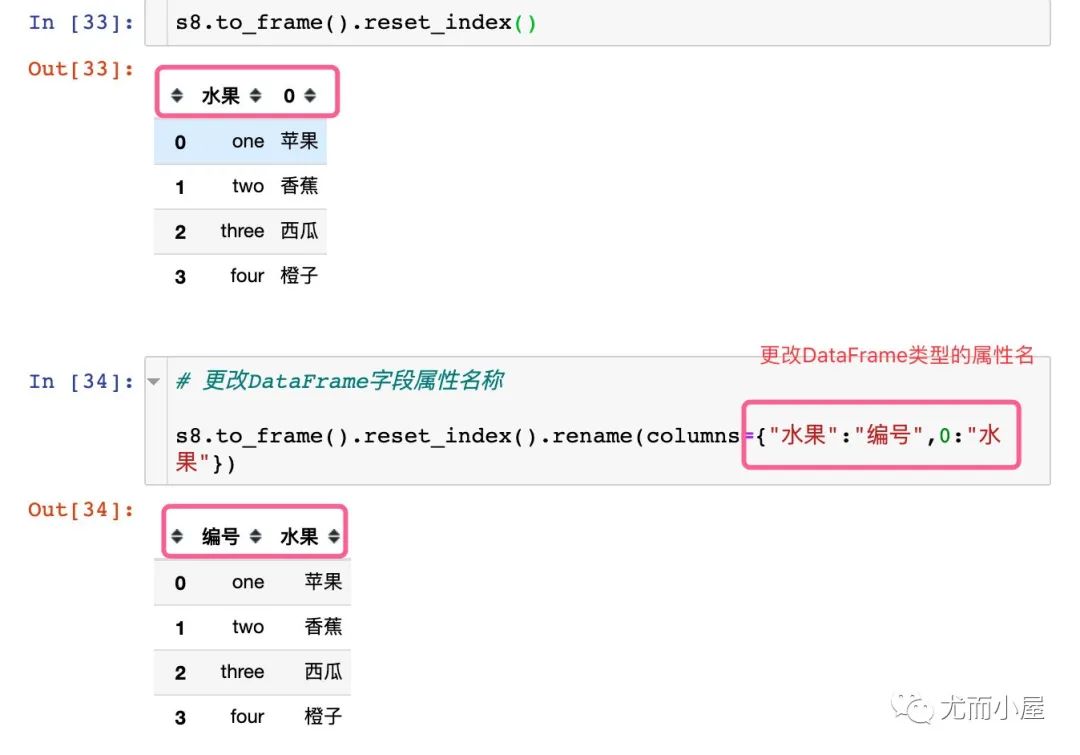Series 详解
Series DataFrame
内容导图
Series
Series 是一维数组结构,它仅由 index(索引)和value(值)构成的。
Series 的索引具有唯一性,索引既可以是数字,也可以是字符,系统会自动将它们转成一个 object 类型(pandas 中的字符类型),如下图所示:
DataFrame 类型
DataFrame 是将数个 Series 按列合并而成的二维数据结构,每一列单独取出来是一个 Series ;除了拥有 index 和 value 之外,还有 column。如下图所示:
索引 index:0,1,2,3……. 字段属性:fruit、number 值 value:苹果、葡萄等;200、300 等
导入库
先导入两个库:
import pandas as pd
import numpy as np
Series类型创建与操作
通过可迭代类型列表、元组生成 通过 python 字典生成 通过 numpy 数组生成
列表生成
通过列表的方式生成 Series 数据
s1 = pd.Series([7,8,9,10])
s1
# 结果
0 7
1 8
2 9
3 10
dtype: int64
s2 = pd.Series(list(range(1,8)))
s2
# 结果
0 1
1 2
2 3
3 4
4 5
5 6
6 7
dtype: int64
元组生成
下面的方法是通过元组生成 Series 数据
s3 = pd.Series((7,8,9,10,11))
s3
# 结果
0 7
1 8
2 9
3 10
4 11
dtype: int64
s4 = pd.Series(tuple(range(1,8))) # 从1到8,不包含8
s4
# 结果
0 1
1 2
2 3
3 4
4 5
5 6
6 7
dtype: int64
使用字典创建
字典的键为索引,值为 Series 结构对应的值
dic_data = {"0":"苹果", "1":"香蕉", "2":"哈密瓜","3":"橙子"}
s5 = pd.Series(dic_data)
s5
# 结果
0 苹果
1 香蕉
2 哈密瓜
3 橙子
dtype: object
使用 numpy 数组
s6 = pd.Series(np.arange(3,9))
s6
# 结果
0 3
1 4
2 5
3 6
4 7
5 8
dtype: int64
指定索引(列表)
默认的索引都是从 0 开始的数值,可以在创建的时候指定每个索引
# 默认
s1 = pd.Series([7,8,9,10])
s1
# 结果
0 7
1 8
2 9
3 10
dtype: int64
s7 = pd.Series([7,8,9,10], index=["A","B","C","D"]) # 指定索引值
s7
# 结果
A 7
B 8
C 9
D 10
dtype: int64
指定索引(字典形式)
字典的键作为索引值
dic_data = {"水果1":"苹果",
"水果2":"香蕉",
"水果3":"哈密瓜",
"水果4":"橙子"
}
s8 = pd.Series(dic_data)
s8
# 结果
水果1 苹果
水果2 香蕉
水果3 哈密瓜
水果4 橙子
dtype: object
查看索引值
s8
# 结果
水果1 苹果
水果2 香蕉
水果3 哈密瓜
水果4 橙子
dtype: object
s8.index # 查看索引值
# 结果
Index(['水果1', '水果2', '水果3', '水果4'], dtype='object')
查看值
s8
# 结果
水果1 苹果
水果2 香蕉
水果3 哈密瓜
水果4 橙子
dtype: object
s8.values
# 结果
array(['苹果', '香蕉', '哈密瓜', '橙子'], dtype=object)
更改索引
# 1、新索引
index_new = ['one', 'two', 'three', 'four']
# 2、赋值
s8.index = index_new
s8
# 结果
one 苹果
two 香蕉
three 哈密瓜
four 橙子
dtype: object
查看是否存在空值
s7
# 结果
A 7
B 8
C 9
D 10
dtype: int64
s7.isnull() # 没有空值
# 结果
A False
B False
C False
D False
dtype: bool
s7.notnull()
# 结果
A True
B True
C True
D True
dtype: bool
查看某个索引的值
s7
A 7
B 8
C 9
D 10
dtype: int64
两种方式查看:
通过自定义的索引查看 通过对应的数值索引查看
s7["A"] # 自定义的索引值
7
s7[0] # 默认的数值索引
7
s7["D"]
10
s7[3]
10
将 Series 转成字典
s_dic = s7.to_dict() # 转成字典形式
s_dic
# 结果
{'A': 7, 'B': 8, 'C': 9, 'D': 10}
type(s_dic) # 结果显示为字典类型
# 结果
dict
给 Series 索引命名
s8
# 结果
one 苹果
two 香蕉
three 哈密瓜
four 橙子
dtype: object
s8.index # 原索引
Index(['one', 'two', 'three', 'four'], dtype='object')
s8.index.name = "水果" # 索引命名
s8
结果显示为:
水果
one 苹果
two 香蕉
three 哈密瓜
four 橙子
dtype: object
s8.index # 更改之后的索引
Index(['one', 'two', 'three', 'four'], dtype='object', name='水果')
修改 Series 数值
s8
# 结果为
水果
one 苹果
two 香蕉
three 哈密瓜
four 橙子
dtype: object
s8["three"] = "西瓜" # 等价于s8[2] = "西瓜"
s8
更改之后的值为:
水果
one 苹果
two 香蕉
three 西瓜
four 橙子
dtype: object
Series 转为 DataFrame
s8
水果
one 苹果
two 香蕉
three 西瓜
four 橙子
dtype: object
在将 s8 转成 DataFrame 的过程中涉及到 3 个函数:
to_frame:转成 DataFrame reset_index:DataFrame 类型的索引重置 rename:DataFrame 的字段属性重置
关于 DataFrame 的相关内容下节详细讲解,敬请期待!
评论


